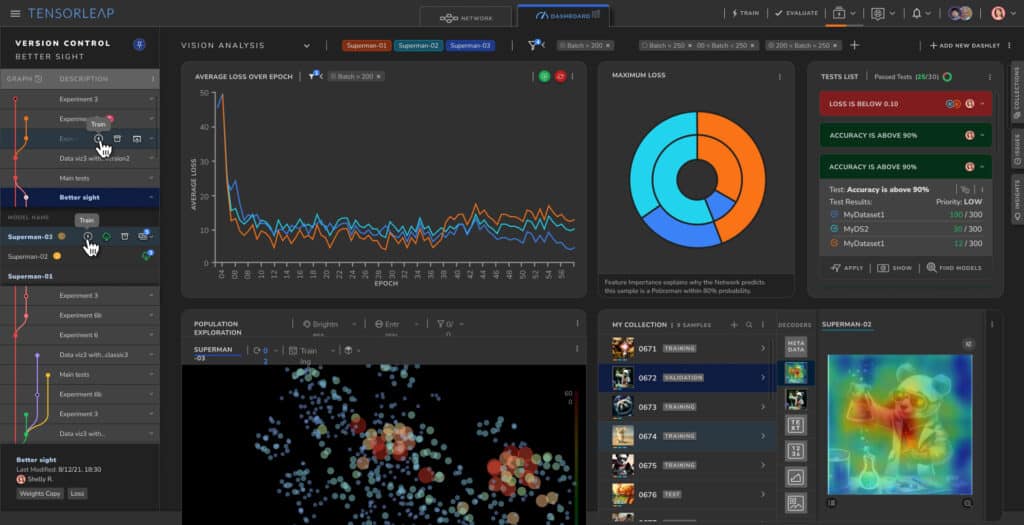Rebecca Kopans
Data scientists developing neural networks face enormous difficulties trusting their models before they go to production. Tensorleap’s pioneering platform is a game changer: the start-up enables data scientists to have confidence in their AI models, allowing a wide range of industries to leverage deep learning to solve their toughest challenges
Data scientists developing neural networks for AI applications contend with a frustrating obstacle: the inability to conclusively understand how the models make the decisions that they do and the need to resort to unscientific intuition and trial-and-error to develop very complex models. In addition to being unreliable and resulting in numerous inexplicable failures, this approach is extremely time-consuming and expensive.
In many cases, not understanding how artificial neural networks make their decisions is the main hurdle preventing cutting-edge technologies, such as self-driving vehicles, from being implemented on a large scale. “In the last decade, the world of AI has provided solutions to many problems that humanity hadn’t considered solving previously,” explains Yotam Azriel, CTO of the Israeli start-up Tensorleap. “Neural networks became enablers for many different markets, but their success has been hampered by an outdated development paradigm that has resulted in unreliable models.”
In a nutshell, artificial neural networks make it possible to detect infinite amounts of patterns on which decisions can be made. Still, data scientists don’t know how these artificial models actually decide which patterns to use. The result is a “black box.” If the AI experts developing the models do not know which features the model used to make a decision, they are unable to accurately test it. This leads to the current testing paradigm that results in running the model on a very large randomly selected sample, aggregating the performance metric on this sample set, and setting a target that sounds high.
The problem is that data scientists tend to approach neural networks using the same development paradigms as they did with classic machine learning, by creating many experiments, training the model many times and testing it on big subsets of samples. In the past, the model could easily be simulated in a short amount of time. With neural networks, however, the models and datasets are enormous, and data scientists don’t have the right tools to test the models, so the likelihood of failing is high. Using existing techniques, it could take months to test a single neural network properly and much longer to find and resolve the root cause of a failure.

Moreover, since the pattern the model used is unknown, data scientists struggle to identify what data they need, and as a result, they often collect vast amounts of repetitive and irrelevant data. The computing capabilities required to handle large datasets are beyond the reach of smaller companies.
Global breakthrough
Tensorleap has developed a groundbreaking, sophisticated mathematical technique that can penetrate the neural networks’ “brain” and continuously record all of the neurons’ activity, making it possible for the first time to completely explain why neural networks make the decisions that they do. The company has, in fact, pioneered a new field: Applied Explainability.
Indeed, following three years of intensive research carried out by top AI experts, Tensorleap successfully built a massive infrastructure that can manage large amounts of data extracted from active neural networks. The system is capable of explaining the way the neural networks interpret reality, including how they make decisions and why they underperform. This is especially impressive given that neural networks sometimes contain billions of parameters, creating enormous amounts of data to analyze that require huge amounts of computing.
“When our clients work on a neural network, we can find all the use cases that tend to fail along with the root cause and automatically tell them which samples to add to the dataset. We can explain which type of information in the samples will help the model perform well and will give them the confidence they need to deploy these new models to production,” Azriel elaborates, adding, “We can prove mathematically that the models will perform well in production. We can also explain why the models make certain decisions. No need to rely on hunches anymore.”
Six months ago, Tensorleap went out of stealth mode and started offering its novel technology to clients around the world. The company participated in several conferences, attracting a great deal of interest thanks to its ability to resolve a crucial problem for AI developers. “The response is amazing. There are already dozens of companies using our platform constantly,” says Azriel.
Some of the larger clients, which deploy their own computing infrastructure, purchase Tensorleap’s software and install it on their system. For others, Tensorleap provides software based on a SaaS model, which allows subscription-based access to the platform.
The company’s clients mainly come from three verticals: healthcare, autonomous vehicles, and manufacturing. Clients in the healthcare sector, such as those trying to detect cancer in digital pathology, use Tensorleap’s technology to keep track of models and dramatically reduce failures. Manufacturing companies are able to validate their models prior to producing products such as electronic circuit boards.
Izhak Haviv, the Chief Scientific Officer of AID Genomics, attests that, “Using Tensorleap, we are able to detect many failing populations out of a very complex preprocessing pipeline that allows us to run neural networks on genetic data. The quick roundtrip of detecting and explaining root causes allowed us to reach reliable models in no time.”
Tensorleap owes its outstanding results to its team of excellent engineers, all of whom have many years of experience developing deep-tech technologies. The CEO is seasoned tech executive David Ben David. Azriel himself has been deeply involved in the field of AI since he was a teenager. The start-up completed a successful seed round totaling $7.7 million, as well as receiving funding from the Israeli government.
Clients report high levels of satisfaction and the unprecedented ability to develop highly accurate and reliable neural networks much faster. Clearly, the potential is enormous.
